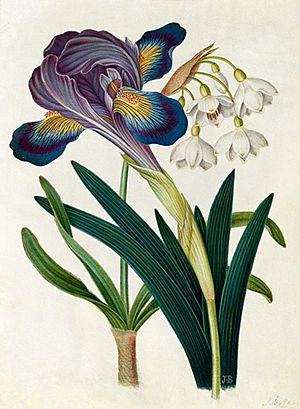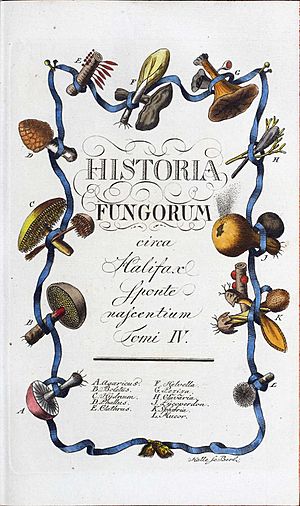James Bolton facts for kids
Quick facts for kids
James Bolton
|
|
|---|---|

Iris and Summer Snowdrop by James Bolton.
No likeness of James Bolton is known to exist. A published portrait once thought to be of him is actually of a London engraver of the same name. |
|
| Born | 1735 West Field, Warley, West Riding of Yorkshire, England
|
| Died | 7 January 1799 Warley, Yorkshire, England
|
| Nationality | English |
| Known for | Contributions to the taxonomy of ferns and fungi |
| Scientific career | |
| Fields | Natural history |
| Author abbrev. (botany) | Bolton |
James Bolton (born 1735, died 1799) was an amazing English scientist who studied nature. He was a naturalist, a botanist (someone who studies plants), a mycologist (someone who studies fungi), and a very talented artist who drew what he saw.
Contents
Early Life and Discoveries
James Bolton was born in 1735 near a place called Warley in Yorkshire, England. His father, William Bolton, was a weaver, which means he made cloth. James first followed in his father's footsteps. Later, he taught himself art and eventually became a publican, running a local pub in his village.
In 1768, James married Sarah Blackburn, and they had four children. His family lived their whole lives in the area around Halifax.
James had an older brother named Thomas Bolton (1722–1778), who was also very interested in nature. Thomas especially loved studying insects and birds. A type of dragonfly, Cordulegaster boltonii, was even named after a specimen Thomas collected! Both brothers helped write a section about nature in a book about the history of Halifax, published in 1775. After this, James Bolton started writing and illustrating his own important books about nature.
Discovering Ferns and Flowering Plants
In 1785, James Bolton drew the pictures for a book called Flora Cantabrigiensis, which was about plants in Cambridge. In the same year, he published the first part of his own book, Filices Britannicae. This book was a two-volume set all about British ferns.
James Bolton didn't just draw the pictures; he also made the etchings (a type of printmaking) himself. He didn't just copy information from other books. Instead, he did his own original research and went out into the fields to study ferns. His book even included a description and drawing of a new fern species, which is now known as Woodsia alpina.
Around this time, a very rich lady named Margaret Bentinck, Duchess of Portland (1715–1785) asked Bolton to draw plants from her amazing museum collection.
Even though many of his other drawings of native and exotic flowering plants were never published, some of his original watercolour paintings still exist today. You can find some of them at the Natural History Museum in London, the Liverpool Museum, and the Lindley Library at the Royal Horticultural Society.
In 1788, a genus (a group of related plants) called Boltonia was named in his honour. These plants are part of the Compositae family, which includes daisies and sunflowers.
Exploring Fungi
James Bolton was most interested in fungi, like mushrooms and toadstools. He carefully collected them, carried them home in his special collecting box called a vasculum, and then drew them. He also wrote letters to many other famous mycologists (fungi experts) of his time.
All his hard work led to the first English-language book completely about fungi! It was Bolton's three-volume work called An History of Fungusses growing about Halifax, published between 1788 and 1790, with an extra part in 1791. He dedicated this book to Henry Noel, the 6th Earl of Gainsborough, who helped pay for the project.
Just like with his fern book, Bolton not only drew the illustrations but also made the etchings, which were then coloured by hand. Many of the fungi he wrote about were new to science. Some of these familiar fungi include the Wood Woollyfoot, the inkcap, the Cramp Ball, the bracket fungus, the agaric, and the Fairy-Ring Champignon. His book was so important that it was translated into German.
There is also a special album of 233 unpublished paintings of fungi, called Icones fungorum circa Halifax nascentium, kept in the United States Department of Agriculture library. Other drawings are at the Natural History Museum and in the library of the Earl of Derby.
Not many of Bolton's actual fungi collections still exist today. However, some of his specimens can be found at the Royal Botanic Gardens, Kew and the Edward Robson herbarium at Sunderland Museum.
Studying Songbirds
Bolton's last published work was Harmonia ruralis, which was about the natural history of British songbirds. It came out in two volumes between 1794 and 1796. He drew birds and their nests exactly as he saw them in nature. The text also included many of Bolton's own observations from watching the birds. This book was very popular, and new editions were published even after he died, in 1830 and 1845.
Works
- An History of Fungusses, Groving About Halifax, 4 volumes, Huddersfield, 1788–1791.
James Bolton Today
James Bolton's work is still important today! An exhibition about him and his work was held at the Liverpool Museum in 1995-1996. He was also one of the artists featured in the Nature Observed exhibition at the University of London in 2006.
Bolton's books on ferns and fungi, with their descriptions of new species, are still valuable for scientists. His beautiful bird studies from Harmonia ruralis are also still very popular. You can find them reproduced as prints, on table mats, coasters, and even tea towels!


